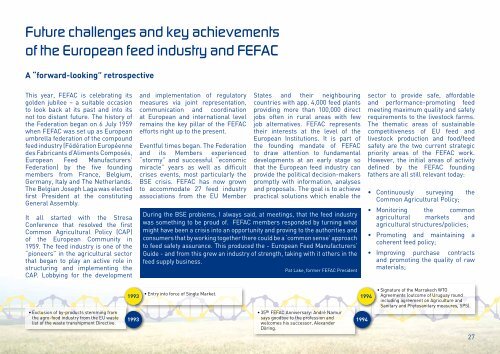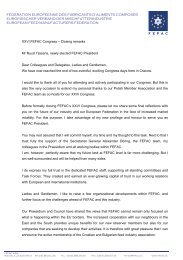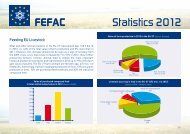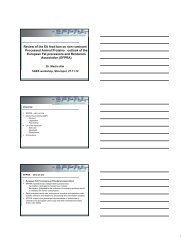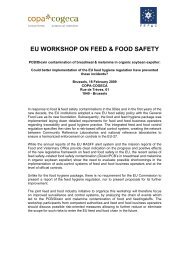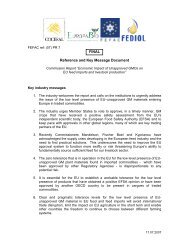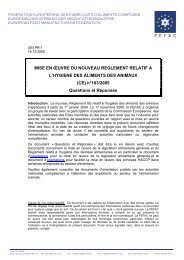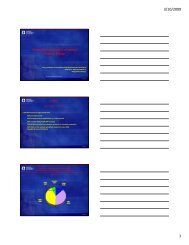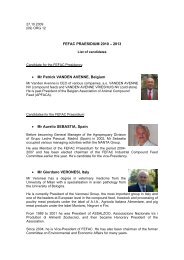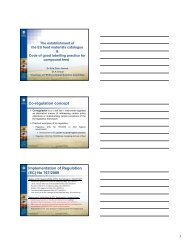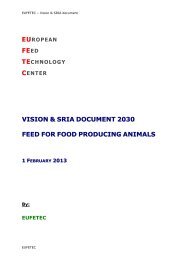Brochure (PDF) - Fefac
Brochure (PDF) - Fefac
Brochure (PDF) - Fefac
Create successful ePaper yourself
Turn your PDF publications into a flip-book with our unique Google optimized e-Paper software.
Future challenges and key achievements<br />
of the European feed industry and FEFAC<br />
A “forward-looking” retrospective<br />
This year, FEFAC is celebrating its<br />
golden jubilee – a suitable occasion<br />
to look back at its past and into its<br />
not too distant future. The history of<br />
the Federation began on 6 July 1959<br />
when FEFAC was set up as European<br />
umbrella federation of the compound<br />
feed industry (Fédération Européenne<br />
des Fabricants d’Aliments Composés,<br />
European Feed Manufacturers’<br />
Federation) by the five founding<br />
members from France, Belgium,<br />
Germany, Italy and The Netherlands.<br />
The Belgian Joseph Laga was elected<br />
first President at the constituting<br />
General Assembly.<br />
It all started with the Stresa<br />
Conference that resolved the first<br />
Common Agricultural Policy (CAP)<br />
of the European Community in<br />
1959. The feed industry is one of the<br />
“pioneers” in the agricultural sector<br />
that began to play an active role in<br />
structuring and implementing the<br />
CAP. Lobbying for the development<br />
• Exclusion of by-products stemming from<br />
the agro-food industry from the EU waste<br />
list of the waste transhipment Directive.<br />
1993<br />
1993<br />
and implementation of regulatory<br />
measures via joint representation,<br />
communication and coordination<br />
at European and international level<br />
remains the key pillar of the FEFAC<br />
efforts right up to the present.<br />
Eventful times began. The Federation<br />
and its Members experienced<br />
“stormy” and successful “economic<br />
miracle” years as well as difficult<br />
crises events, most particularly the<br />
BSE crisis. FEFAC has now grown<br />
to accommodate 27 feed industry<br />
associations from the EU Member<br />
States and their neighbouring<br />
countries with app. 4,000 feed plants<br />
providing more than 100,000 direct<br />
jobs often in rural areas with few<br />
job alternatives. FEFAC represents<br />
their interests at the level of the<br />
European Institutions. It is part of<br />
the founding mandate of FEFAC<br />
to draw attention to fundamental<br />
developments at an early stage so<br />
that the European feed industry can<br />
provide the political decision-makers<br />
promptly with information, analyses<br />
and proposals. The goal is to achieve<br />
practical solutions which enable the<br />
During the BSE problems, I always said, at meetings, that the feed industry<br />
was something to be proud of. FEFAC members responded by turning what<br />
might have been a crisis into an opportunity and proving to the authorities and<br />
consumers that by working together there could be a ‘common sense’ approach<br />
to feed safety assurance. This produced the - European Feed Manufacturers’<br />
Guide - and from this grew an industry of strength, taking with it others in the<br />
feed supply business.<br />
• Entry into force of Single Market.<br />
Pat Lake, former FEFAC President<br />
• 35 th FEFAC Anniversary: André Namur<br />
says goodbye to the profession and<br />
welcomes his successor, Alexander<br />
Döring.<br />
1994<br />
1994<br />
sector to provide safe, affordable<br />
and performance-promoting feed<br />
meeting maximum quality and safety<br />
requirements to the livestock farms.<br />
The thematic areas of sustainable<br />
competitiveness of EU feed and<br />
livestock production and food/feed<br />
safety are the two current strategic<br />
priority areas of the FEFAC work.<br />
However, the initial areas of activity<br />
defined by the FEFAC founding<br />
fathers are all still relevant today:<br />
• Continuously surveying the<br />
Common Agricultural Policy;<br />
• Monitoring the common<br />
agricultural markets and<br />
agricultural structures/policies;<br />
• Promoting and maintaining a<br />
coherent feed policy;<br />
• Improving purchase contracts<br />
and promoting the quality of raw<br />
materials;<br />
• Signature of the Marrakech WTO<br />
Agreements (outcome of Uruguay round<br />
including agreement on Agriculture and<br />
Sanitary and Phytosanitary measures, SPS).<br />
27


